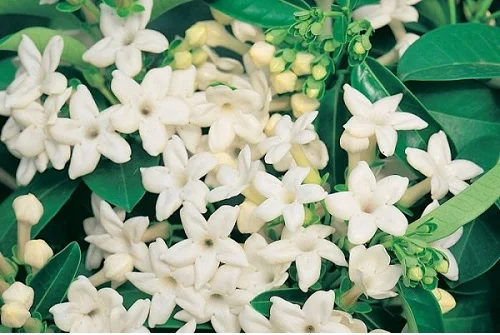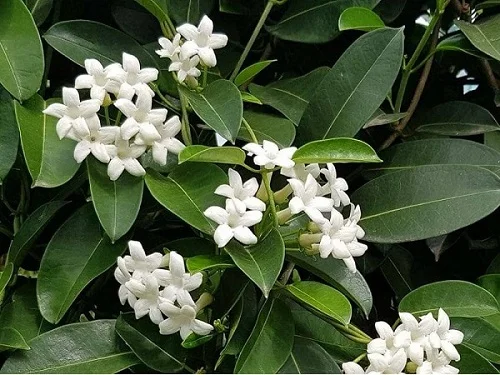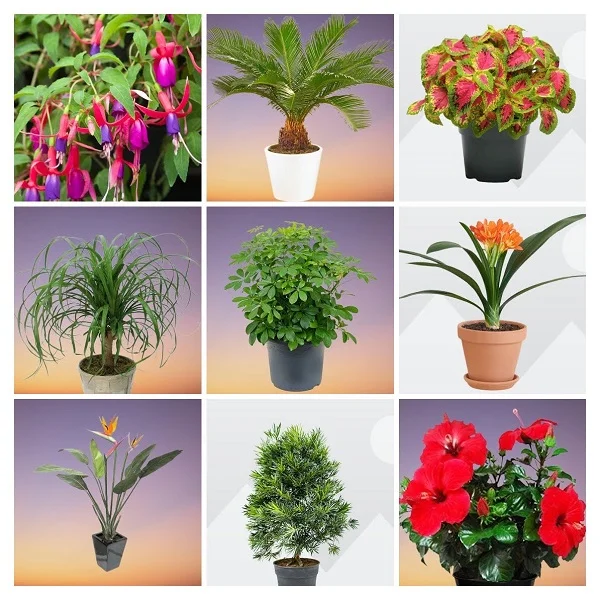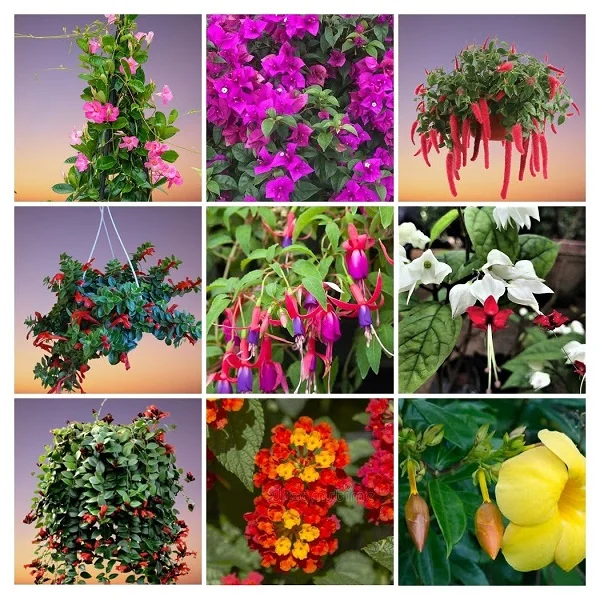Stephanotis floribunda (Madagascar Jasmine) Care, Propagation, Problems and Solutions
Some links in this post may be affiliate links
Madagascar Jasmine (Stephanotis floribunda) blooms in bright light with some direct sunshine, average warmth, humid conditions and consistently moist, rich, well-drained soil coupled with monthly feeding in the growing season.
Stephanotis floribunda also called Hawaiian Wedding Flower, Bridal Wreath or Clustered Wax Flower is among the evergreen, woody, climbing, flowering plants with white, waxy, star-shaped, tubular, sweet-scented flowers and glossy, dark-green, oval leaves.
Bridal Wreath Plant is a vigorously growing, hardy climbing plant that will flourish in a hanging basket or on a trellis. It is one of the best flowering plants for hanging baskets.
Though called Jasmine, Madagascar Jasmine is not a Jasmine. It belongs to the family Apocynaceae (Dogbane family) along with Golden Trumpet (Allamanda cathartica) and Wax Plant (Hoya carnosa). True Jasmines belong to the family Oleaceae (Olive family) an example being Pink Jasmine (Jasminum polyanthum).

Botanical name: Stephanotis floribunda
Synonmy: Stephanotis jasminoides
Family: Apocynaceae
Common names: Madagascar Jasmine, Hawaiian Wedding Flower, Bridal Wreath, Clustered Wax Flower, Bridal Veil Vine
Origin
Stephanotis floribunda also called Stephanotis jasminoides is native to Madagascar where it climbs on trees to get to the canopy for some direct sunlight.
Size
Madagascar Jasmine can grow to a height of about 20 feet. When grown indoors, the growth can be controlled through trimming at the beginning of the growing season.
Flower
Stephanotis floribunda flowers are white, waxy, star-shaped, tubular, sweet-scented and borne on new growth in spring through fall. The flowers are a common feature in bridal wreaths, hence the common names, 'Bridal Wreath', 'Hawaiian Wedding Flower' and 'Bridal Veil Vine'.
Toxicity
The American Society for the Prevention of Cruelty to Animals indicates that Madagascar Jasmine is non-toxic to pets. It is one of the pet-safe plants you may grow in any space.
Where to Buy
If you are looking to add this beautiful plant to your collection, Hawaiian Wedding Flower is available online on Etsy (Link to Etsy).
Stephanotis floribunda Care Indoors
Madagascar Jasmine (Stephanotis floribunda) blossoms in bright light with 4-6 hours of direct sunshine, average warmth of 20-250C, humidity of 55-65% and consistently moist, fertile, well-drained, all purpose soil coupled with monthly feeding during the growing season.
Stephanotis floribunda requires repotting only when pot-bound as it blooms best when the roots are confined. Pruning is needed to keep the plant neat, to minimize pest and disease infestations, to promote flowering and to rejuvenate growth. Keep on reading for more on these growing conditions and how to achieve them.

Light Requirements
Stephanotis floribunda thrives in bright light with 4-6 hours of morning or evening sunshine. Keep it away from hot midday sunshine to avoid scorching of the leaves.
If light is not enough, it will become leggy with wide spaces between the leaf nodes and will not bloom. Therefore, you may grow the plant under a grow light where the natural light is inadequate. Take a look at these full spectrum grow lights on Amazon.
Rotate the pot regularly to ensure the plant receives light on all sides for even growth and prevent leggy growth.
The Bridal Wreath Plant can also be grown outside under direct sunshine but it needs to be acclimated gradually before being exposed to direct sunshine to avoid sunscorch. It is one of the best sun-loving plants for growing in the home.
Watering
Water Stephanotis floribunda thoroughly during the growing season while allowing the top 1-2 inches to dry out between water to keep the soil consistently moist.
Decrease watering during the cold season to maintain the soil slightly moist as growth is minimal at this time. Do not allow the soil to dry out as it can lead to wilting and leaf drop.
Ascertain that the soil is free-draining and the pot has a drainage hole to avoid getting soggy soil as it can lead to root-rot and loss of the plant.
Temperature and Humidity
Average warmth of 20-250C is ideal for Madagascar Jasmine. Keep it away from drafty conditions as cold temperatures can cause leaf drop.
A room humidity of 55-65$ is ideal for Madagascar Jasmine. The plant thrives in warm, humid conditions like in its natural environment. To raise humidity, set the pot on a wet pebble tray or use a cool mist humidifier to prevent brown leaf tips and edges.
Occasionally clean the leaves by damp-wiping with a soft cloth to get rid of dust and reduce infestation by pests. Make sure that there is good air circulation to prevent fungal diseases.
Fertilizer
Feed Stephanotis floribunda with a phosphorous-rich, water-soluble fertilizer every 3-4 weeks during the growing season to promote flowering. Do not feed in the cold season as growth is minimal at this time and feeding at this time can cause fertilizer burn.
Potting Mix
The best soil for Madagascar Jasmine should be rich in organic matter and free-draining to prevent it from getting soggy while providing the required nutrients. Most all purpose potting mixes are ideal for the plant.
Repotting
Repot young Madagascar Jasmine at the beginning of the growing season into a pot only one size larger than the current. It blooms best when root-bound, therefore repot only when pot-bound.
Make sure that the pot has a drainage hole and the soil is free-draining soil to avoid getting soggy soil as it can lead to root-rot. Do not repot a plant that is in flower as the repotting shock can shorten the flowering period. Check out these pots with drainage holes on Amazon.
Pruning
Pruning Stephanotis floribunda involves removal of dead blooms and leaves to maintain the plant neat and discourage pest and disease infestations.
Cutback the stems at the beginning of the growing season to rejuvenate growth as the plant becomes straggly and unattractive with age. It also encourages flowering as flowers are borne on new growth.
Propagation
Stephanotis floribunda (Madagascar Jasmine) can be propagated at the beginning of the growing season from stem cuttings.
How to propagate Madagascar Jasmine from stem cuttings
Take a 4-6 inches stem cuttings from a healthy Madagascar Jasmine. Strip off the lower leaves of the cuttings and coat the lower part of the stem with a rooting hormone.
Carefully insert the coated cuttings in moist, free-draining soil and ensure the rooting container has adequate drainage holes to prevent the soil from getting soggy as it can lead to rotting.
Cover the set up with a clear plastic bag or sheet to create a greenhouse effect to hasten rooting. A warm and humid environment is needed for rooting to happen.
Place the set up in bright light but away from direct sunlight to avoid cooking the cuttings.
Maintain the soil moist through out until the Hawaiian Wedding Flower cuttings are rooted. Rooting should occur in about 4-6 weeks and is indicated by new growth.
Once rooted, remove the plastic cover a little every day over a period of 2 weeks to acclimate the ne plants to normal indoor growing conditions.
Allow the new Stephanotis floribunda to be well established before transplanting after which you can begin routine care.

Stephanotis floribunda Growing Problems
Stephanotis floribunda (Madagascar Jasmine) problems include yellow leaves, lef drop, flowerbud drop, lack of blooms, wilting and drooping, brown leaf tips and edges, pests and diseases among others. Keep reading for more on these problems and how to fix them.
Pests
The common pests in Madagascar Jasmine are mealybugs, scales and spider mites. Isolate the affected plant to prevent spread to the other plants and treat it with neem oil as per the manufacturer's instructions.
No blooms (flowers)
The are three possible causes of lack of blooming in Madagascar Jasmine. One possible reason is too little light. Move the plant to a brighter spot where it can receive bright light with 4-6 hours of morning sunshine or instal grow lights where natural lighting is not adequate. Check out this post on understanding light for houseplants.
The second possible reason why Madagascar Jasmine will not bloom is feeding it with a nitrogen-rich fertilizer which promotes foliage growth at the expense of flowering. Feed the plant with a phosphorous-rich, water-soluble fertilizer every 3-4 weeks during the growing season to promote flowering. Learn how to feed houseplants.
The third possible reason why Madagascar Jasmine is not blooming is underwatering. Water the plant thoroughly during the growing season and keep the soil moist through out. Reduce watering in the cold season to maintain the soil slightly moist. Do not allow the soil to dry out completely. Learn more on how to water houseplants the right way.
Brown leaf tips and edges
Two reasons are responsible for brown leaf tips and edges in Madagascar Jasmine. One reason for brown leaf tips and edges is low humidity. Set the pot on a wet pebble tray or use a cool mist humidifier to raise humidity. Check out these techniques on how to increase humidity for houseplants.
The second reason for brown leaf tips and edges in Stephanotis floribunda is soggy soil. Maintain the soil moist but not soggy by ensuring that the pot has a drainage hole and that the soil drains easily.
Yellowing and dropping leaves
Yellowing leaves accompanied by leaf drop in Madagascar Jasmine is caused by two possible reasons. One possible reason is soggy soil. Ensure that the pot has a drainage hole and that the soil is free-draining to prevent it from getting soggy.
The second reason for yellowing and dropping leaves in Stephanotis floribunda is sudden drop in temperatures brought about by cold drafts. The plant is a tropical plant where temperatures are constantly warm through out the year, thus cannot tolerate low temperatures.
Keep the plant away from cold vents, drafty windows and doorways and maintain an average warmth of 20-250C. Check out this guide on understanding temperature for houseplants.
Wilting and droopy leaves
Underwatering is the cause of wilting and droopy leaves in Madagascar Jasmine. Water the plant thoroughly and maintain the soil moist during the growing season. Lessen watering in the cold season to keep the soil slightly moist but do not allow the soil to dry out completely.
Flower drop
Flower drop in Stephanotis floribunda is due to three possible causes. One possible cause of flower drop is soggy soil. Ascertain that the pot has a drainage hole and that the soil is free-draining to prevent it from getting soggy.
In addition, reduce watering in the cold season as growth is minimal at this time but do not allow the soil to dry out completely.
The second cause of flower drop in Madagascar Jasmine is underwatering. Water the plant thoroughly and maintain the soil moist during the growing season. Reduce watering during the cold season but do not allow the soil to dry out completely.
The third possible cause of flower drop in Hawaiian Wedding Flower is sudden changes in the growing conditions. Do not move or repot a plant that is in flower. The sudden changes will cause plant shock which will result in flower drop and sometimes leaf drop.
You liked it? Share on social media.
Related Content
Amazon Associates Disclosure
Homeplantsguide.com is a participant in the Amazon Services LLC Associates Program, an affiliate advertising program designed to provide a means for sites to earn advertising fees by advertising and linking to amazon.com.





